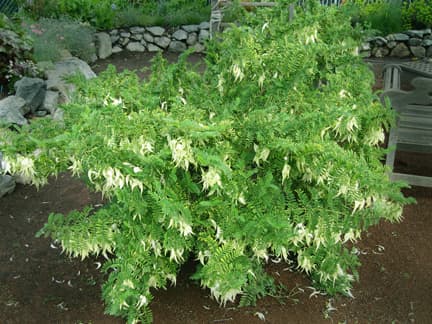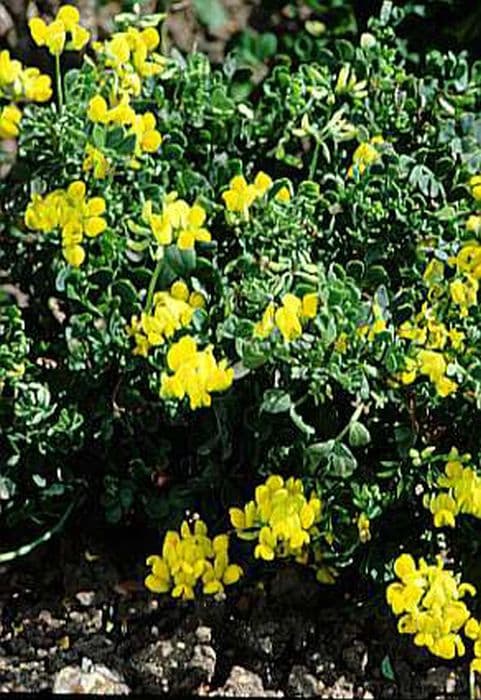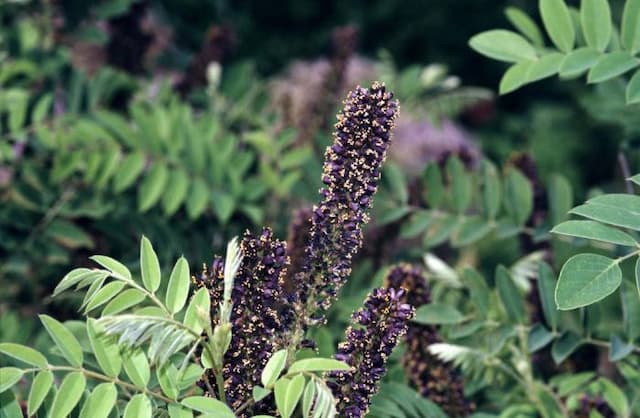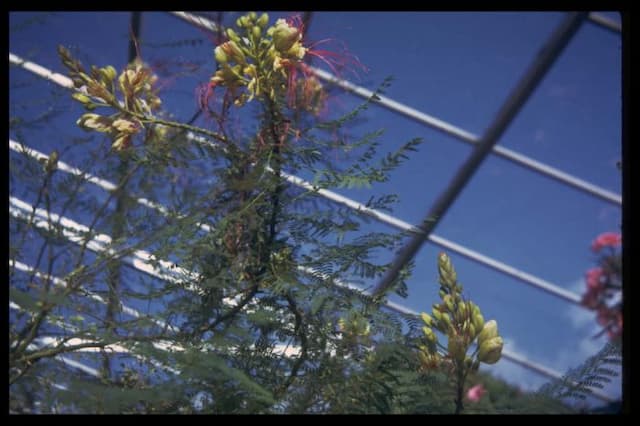Hairy Lotus Lotus hirsutus
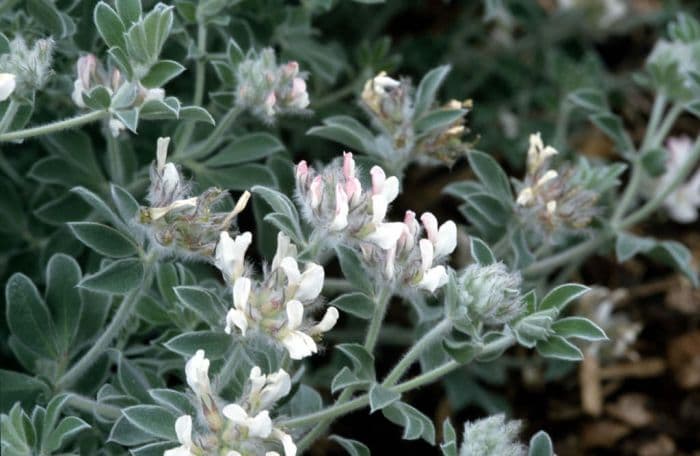
ABOUT
The Lotus hirsutus, commonly known as the Hairy Lotus, is a perennial plant that is notable for its distinctive foliage and flowers. The leaves are silvery-green, covered with fine hairs that give them a soft, tactile texture. This hairiness is where the plant gets its common name from, creating a shimmering effect when light catches the surface. The plant produces striking flowers that are a vibrant blue to violet in color, with a typical lotus shape. Each flower consists of petals that are arranged in a layered pattern, offering a rich and colorful display. The blooms are usually seen forming in clusters, creating a striking contrast against the silvery foliage beneath them. Moreover, the Hairy Lotus has seed pods that are also quite interesting to look at. After flowering, these pods emerge, starting green and becoming brown as they mature, with a visual texture that is often described as attractive in a garden setting. The appearance of the seed pods adds an additional ornamental value to the plant's overall aesthetics. This plant is appreciated for its unique look and is often used in gardens for its ornamental qualities, being well-suited to adding a touch of color and texture to outdoor spaces.
About this plant
 Names
NamesFamily
Fabaceae.
Synonyms
Dorycnium hirsutum, Hairy Canary Clover, Hairy Lotus, Hirsute Bird's-foot Trefoil, Hairy Bird's-foot Trefoil.
Common names
Lotus hirsutus.
 Toxicity
ToxicityTo humans
Lotus hirsutus, commonly known as the Greater Bird’s-foot Trefoil, is not known for being toxic to humans. There is no significant evidence to suggest that this plant poses a risk of poisoning upon ingestion. However, as with any plant, individual allergies or sensitivities can occur, so it is always prudent to exercise caution and avoid ingesting plants that are not typically recognized as food sources.
To pets
Greater Bird’s-foot Trefoil (Lotus hirsutus) is also not known to be toxic to pets. It is not listed among common poisonous plants for animals such as dogs and cats. Nevertheless, individual animals may have varying sensitivities, and ingesting plant material can sometimes cause mild gastrointestinal upset in pets, so it is generally wise to prevent pets from consuming this or any unknown plants.
 Characteristics
CharacteristicsLife cycle
Perennials
Foliage type
Deciduous
Color of leaves
Green
Flower color
Yellow
Height
1-2 feet (0.3-0.6 meters)
Spread
1-2 feet (0.3-0.6 meters)
Plant type
Shrub
Hardiness zones
8
Native area
Mediterranean
Benefits
 General Benefits
General Benefits- Ornamental Value: Lotus hirsutus, commonly known as the Dalmatian Toadflax, adds aesthetic value to gardens with its bright yellow flowers and attractive foliage.
- Drought Resistance: Being a hardy plant, it is capable of surviving in dry conditions once established, making it suitable for xeriscaping or drought-prone areas.
- Pollinator Attraction: The blossoms attract bees and other pollinators, which are essential for the health of the ecosystem and the pollination of other plants.
- Low Maintenance: It does not require frequent watering or fertilization, making it an ideal choice for low-maintenance landscapes.
- Soil Erosion Control: The plant's root system can help to stabilize soil and control erosion, particularly on slopes or areas prone to degradation.
- Adaptability: Lotus hirsutus adapts to a variety of soil types, though it prefers well-drained soils, making it versatile for different garden settings.
 Medical Properties
Medical PropertiesThis plant is not used for medical purposes.
 Air-purifying Qualities
Air-purifying QualitiesThis plant is not specifically known for air purifying qualities.
 Other Uses
Other Uses- Floral arrangements: Lotus hirsutus can be used in floral arrangements for its distinctive blue and violet flowers, adding an exotic touch.
- Ground cover: In a garden, this plant can serve as a dense ground cover due to its mat-forming habit, providing an aesthetic green blanket between other plants.
- Erosion control: The Lotus hirsutus, with its sturdy root system, can stabilize soil and help control erosion on slopes.
- Educational purposes: The unique features of Lotus hirsutus, such as its hairy leaves, can be used as a teaching aid in botany classes for plant identification and characteristics.
- Food coloring: Although not commonly used, the vibrant blue of its flowers could potentially be explored for use as a natural food coloring agent.
- Natural dye: The pigments in the flowers might be used in the production of natural dyes for textiles or crafting.
- Fish aquariums: Although not an aquatic plant, its strong aesthetic appeal could be considered for terrestrial sections of paludariums or fishtanks that accommodate semi-aquatic setups.
- Photography subject: The striking appearance of the Lotus hirsutus makes it a popular subject for photographers, particularly those interested in macro photography of plants.
- Plant competitions: Gardeners might cultivate Lotus hirsutus for entry into plant or flower show competitions due to its distinctive beauty and rarity in certain regions.
- Bee foraging: The plant's flowers are attractive to bees, thus helping support local bee populations and pollinator food sources.
Interesting Facts
 Feng Shui
Feng ShuiThe Creeping Gloxinia is not used in Feng Shui practice.
 Zodiac Sign Compitability
Zodiac Sign CompitabilityThe Creeping Gloxinia is not used in astrology practice.
 Plant Symbolism
Plant Symbolism- Beauty and Purity: The Lotus flower is often associated with beauty and purity because it is a plant that blossoms in muddy water, rising above the surface to bloom with remarkable beauty.
- Resilience and Strength: The Lotus hirsutus, also known as Hairy Lotus, symbolizes resilience and strength for its ability to thrive in challenging environments and emerge unsoiled.
- Rebirth and Enlightenment: In many cultures, the Lotus is a symbol of spiritual enlightenment and rebirth, representing an individual's growth and awakening to a higher state of consciousness.
- Divine Perfection: The symmetrical shape of the Lotus petals is often seen as a representation of divine perfection and geometric harmony in nature.
 Water
WaterThe Blue Lotus (Lotus hirsutus), commonly known as Blue Cape Plumbago, requires moderate watering. Ideally, you should water this plant when the top inch of soil feels dry to the touch. Depending on the environment, this might be once every few days during active growth periods in warmer months. Reduce watering in the cooler months to prevent waterlogging, which could occur if the plant is watered too frequently. Ensure that the plant receives approximately 1 gallon of water each time, thoroughly soaking the soil to promote deep root growth.
 Light
LightThe Blue Cape Plumbago thrives in full sun to partial shade. For optimal growth, place it in a location where it can receive at least six hours of direct sunlight daily. However, in regions with very intense sun, some afternoon shade will be beneficial to prevent scorching of the leaves. Ensure that it's not placed in deep shade as this will limit its flowering and overall vitality.
 Temperature
TemperatureThe Blue Cape Plumbago favors warm temperatures and will do best if kept in conditions where the temperature ranges from 50 degrees Fahrenheit at the minimum to around 90 degrees Fahrenheit at the maximum. However, it can withstand short periods of slight frost. Its ideal growing condition is around 70 to 85 degrees Fahrenheit.
 Pruning
PruningPrune the Blue Cape Plumbago to maintain its shape and encourage bushier growth. Pruning is best done in early spring before new growth starts. This plant can be pruned again after the first flush of flowers if desired to encourage a second bloom. Removing spent flowers can also promote repeated flowering throughout the season.
 Cleaning
CleaningAs needed
 Soil
SoilThe best soil mix for the Parrot's Beak should be well-draining with plenty of organic matter, such as a blend of potting soil, perlite, and peat moss. Aim for a slightly acidic to neutral pH of 6.0 to 7.0 for optimal growth.
 Repotting
RepottingParrot's Beak should be repotted every one to two years, preferably during spring. Choose a pot only slightly larger than the previous one to prevent overwatering issues.
 Humidity & Misting
Humidity & MistingParrot's Beak thrives in moderate to high humidity levels but is tolerant of less humid conditions if not too dry. Aim for around 40-50% humidity for the best outcome.
 Suitable locations
Suitable locationsIndoor
Place Parrot's Beak in bright, indirect light indoors and avoid temperature extremes.
Outdoor
Grow Parrot's Beak in full sun to partial shade, protect from harsh elements.
Hardiness zone
9-11 USDA
 Life cycle
Life cycleLotus hirsutus, also known as Hairy Canary Clover, undergoes a typical angiosperm life cycle with distinct stages. The cycle begins with seed germination, wherein the seed absorbs water, swells, and eventually grows a root system and a shoot that reaches toward the light. Once the seedling has established, the vegetative stage follows, where the plant develops a robust root system, stems, and the characteristic trifoliate leaves. During the reproductive stage, Hairy Canary Clover produces flowers, often yellow, which, upon successful pollination, leads to fruit and seed development. The mature seeds are then dispersed by various means, such as wind or animals, to complete the cycle. After seed dispersal, the plant may enter a period of dormancy, particularly in climates with seasonal changes, before the cycle recommences with a new generation of seeds.
 Propogation
PropogationPropogation time
Spring-Early Summer
The most popular method of propagation for Lotus hirsutus, commonly known as Blue Lips, is through seed sowing. The appropriate time for sowing seeds of Blue Lips is usually in the spring after the threat of frost has passed. To propagate by seeds, one should first soak the seeds in water for about 24 hours to soften the tough outer shell. After soaking, the seeds can be sown about an inch deep in a well-draining soil mix. It's essential to maintain moisture in the soil without making it waterlogged to encourage germination. Once the seedlings have developed a few sets of true leaves and have grown strong enough to handle, they can be transplanted to their final location where they can flourish and bloom.
